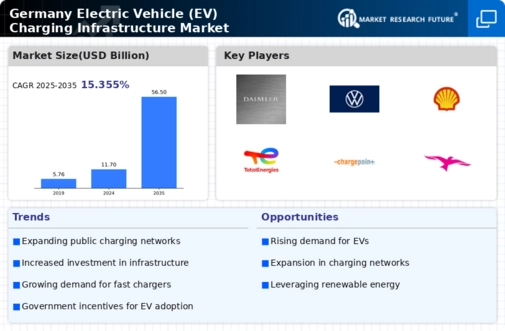Growing EV Adoption Rates
The increasing adoption of electric vehicles in Germany is a primary driver of the Global Germany Electric Vehicle (EV) Charging Infrastructure Market Industry. As consumers become more environmentally conscious and seek sustainable transportation options, the demand for electric vehicles continues to rise. In 2024, the market is expected to be valued at 3.5 USD Billion, reflecting the growing consumer preference for EVs. This trend is anticipated to accelerate further, with projections indicating that the market could reach 15 USD Billion by 2035. The surge in EV adoption necessitates a corresponding expansion of charging infrastructure to support the growing number of electric vehicles on the road.
Market Growth Projections
The Global Germany Electric Vehicle (EV) Charging Infrastructure Market Industry is poised for substantial growth, with projections indicating a market value of 3.5 USD Billion in 2024 and an anticipated increase to 15 USD Billion by 2035. This growth trajectory suggests a compound annual growth rate (CAGR) of 14.14% from 2025 to 2035. Such figures reflect the increasing investments in charging infrastructure, driven by both government initiatives and private sector participation. The market's expansion is likely to be fueled by rising consumer demand for electric vehicles, coupled with advancements in charging technology and the establishment of comprehensive charging networks.
Expansion of Charging Networks
The expansion of charging networks across Germany is a vital driver for the Global Germany Electric Vehicle (EV) Charging Infrastructure Market Industry. As the number of electric vehicles increases, the need for a comprehensive and accessible charging infrastructure becomes paramount. Various stakeholders, including private companies and public entities, are investing in the development of extensive charging networks to ensure that EV users have convenient access to charging stations. This expansion is expected to contribute significantly to the market's growth, with projections indicating a potential market value of 15 USD Billion by 2035, reflecting the increasing infrastructure investments and the growing EV user base.
Public Awareness and Education
Public awareness and education regarding electric vehicles and charging infrastructure are essential components driving the Global Germany Electric Vehicle (EV) Charging Infrastructure Market Industry. As consumers become more informed about the benefits of electric vehicles, including lower operating costs and environmental advantages, their willingness to adopt EVs increases. Educational campaigns and outreach initiatives are crucial in dispelling myths and providing accurate information about charging options. This heightened awareness is likely to contribute to the market's growth, with a projected valuation of 3.5 USD Billion in 2024, as more individuals recognize the advantages of transitioning to electric mobility.
Government Incentives and Policies
The Global Germany Electric Vehicle (EV) Charging Infrastructure Market Industry benefits significantly from robust government incentives and policies aimed at promoting electric vehicle adoption. The German government has implemented various initiatives, including subsidies for EV purchases and investments in charging infrastructure. These measures are designed to encourage consumers to transition to electric vehicles, thereby increasing the demand for charging stations. As a result, the market is projected to reach 3.5 USD Billion in 2024, with expectations of substantial growth as these policies continue to evolve and expand, fostering a supportive environment for the EV ecosystem.
Technological Advancements in Charging Solutions
Technological innovations in charging solutions are playing a crucial role in shaping the Global Germany Electric Vehicle (EV) Charging Infrastructure Market Industry. Developments such as fast-charging technology and smart charging systems enhance the efficiency and convenience of charging electric vehicles. These advancements not only reduce charging times but also enable better integration with renewable energy sources. As a result, the market is likely to experience significant growth, with a projected CAGR of 14.14% from 2025 to 2035. This growth is indicative of the increasing demand for advanced charging solutions that align with the evolving needs of electric vehicle users.
























Leave a Comment